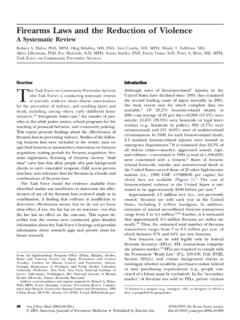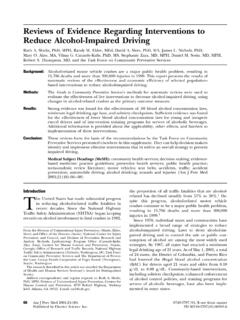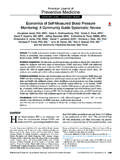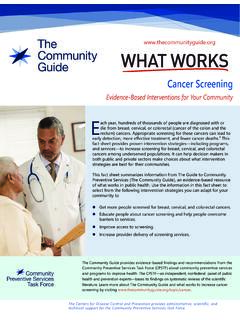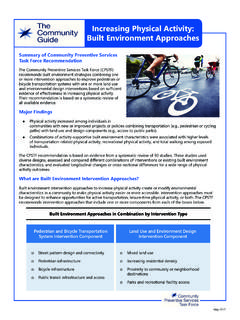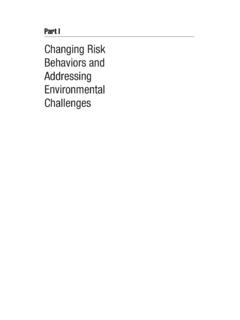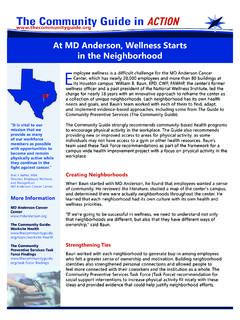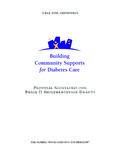Transcription of Understanding and Using the Economic Evidence
1 Chapter 11 Understanding and Using the Economic EvidenceTHE IMPORTANCE OF ECONOMICS TO HEALTH POLICY DECISION MAKINGO btaining Evidence on the effectiveness of public health interventions is acritical first step in selecting those interventions most likely to improve popu-lation health or prevent disease. However, in addition to knowing Whatworks and what is the size of the impact? policymakers need other infor-mation to answer the question What is the best choice of interventions forour program? Public health decision makers, faced with limited resources,must routinely make decisions about how to prioritize public health prob-lems and related interventions and choose among several alternatives.
2 Inmaking such choices, decision makers can benefit by knowing the financialresources required to implement each effective intervention and how dollarsinvested compare to outcomes achieved. Economic evaluations provide thisinformation by comparing the costs and consequences of public health in-terventions (policies, programs, and other activities) (see Table 11 1). Thischapter addresses the rationale and value of systematic reviews of economicevaluations, describes the methods used by the Community Guideto conductsuch reviews, and provides information to help decision makers interpret re-view OF Economic EVALUATION METHODSFour main methods are used in Economic evaluations: cost analysis (CA), cost effectiveness analysis (CEA), cost utility analysis (CUA), and cost benefitanalysis (CBA).
3 Table 11 2 includes a brief description of these methods,what they compare, and the Economic summary measures they AnalysisCost analysis involves the systematic collection and assessment of costs as-sociated with an intervention. These costs are typically expressed as dollarsor dollars per person served by the program. For example, a multicomponentintervention program to promote child vaccinations might cost $23 per child1in the area served. Cost analyses can be conducted alone, but they are often449 This book is out of print. For current reviews, visit with measures of intervention effectiveness in a CEA or CBA.
4 Costanalysis takes into account the costs incurred to develop and implement anintervention, including direct costs, indirect costs, and intangible costs. Directcosts represent the value of resources used specifically for the costs may be characterized as medical or non-medical. Direct medicalcosts can include costs such as clinical services, diagnostic tests, and medi-cations. Direct non-medical costs can be costs such as those associated witha mass media campaign, including media development, training, materials,and the cost of advertising. Indirect costs include the resources that are for-gone to participate in an intervention, typically measured as lost wages orlost leisure time.
5 Economic value can be assigned to each unit of time lostfrom normal activities. Intangible costs, such as the pain, grief, or sufferingassociated with an intervention, can also be considered, but they are difficultto quantify and are seldom included in an Economic costs should be distinguished from the broader concept of eco-nomic costs. Financial costs are the actual dollar costs expended for services,typically the actual costs of care, but in a public health context these also in-clude program costs. Examples of financial costs include staff salaries, rent, andsupplies. In addition to financial cost expenditures, Economic costs includethe opportunity costs or value of a resource for which there is no direct mone-tary expenditure (the value of the benefit that could be derived from the nextbest use of that resource) and the value of intangibles.
6 Examples of opportu-450 Methodological BackgroundTable 11 Use of Economic Data in Public Health: Three Examples from the Centers for Disease Control and PreventionRTI International, in collaboration with economists from the National Center forChronic Disease Prevention and Health Promotion (NCCDPHP, CDC), developed a life-time Economic model to assess the cost-effectiveness of screening for undiagnoseddiabetes. This work resulted in the adoption of a diabetes screening policy by the stateDiabetes Control Programs and a major change in the screening policy of the Ameri-can Diabetes Association (ADA).
7 Economists from the National Center for Infectious Diseases (NCID, CDC) publishedthe first Economic estimates of the potential impact of the next influenza estimates of impact have been incorporated into the national influenza pan-demic response economists developed SAMMEC (Smoking-Attributable Mortality, Morbidity,and Economic Costs), a Web-based computational program available at SAMMEC allows the user to estimate the health and health-relatedeconomic consequences of smoking to adults and infants in terms of the number ofannual deaths, years of potential life lost, medical expenditures, and productivitylosses among adults due to smoking, as well as smoking-attributable infant deathsand excess neonatal healthcare costs.
8 This tool is widely used by both public healthdepartments and book is out of print. For current reviews, visit costs include the value of volunteer time, space in the local public healthdepartment, and donated materials and supplies. Economic costs or financialcosts can be used to compare alternative interventions, though Economic andfinancial costs cannot be directly analysis can include cost-of-illness (COI) estimates, which take intoaccount the direct costs (medical and non-medical) and indirect costs asso-ciated with a health condition. Cost-of-illness analyses are a type of burden-of-disease measure.
9 Cost-of-illness estimates can be incidence-based (reflect-ing total lifetime costs of a disease or illness) or prevalence-based (reflectingtotal costs of a disease in a specific time frame for example, one year, di-vided by the number of cases). Cost analyses that include COI are presentedas net costs, which are calculated by subtracting the cost of the illness (or in-jury) averted from total program costs. For example, the COI of an interven-tion for women with established diabetes that provides preconception care inaddition to prenatal care2would include the total program costs less the costof the illness averted (congenital anomalies).
10 The result is often expressed interms of dollars per person covered by the intervention in this case, net costper program enrollee. Results are sometimes also expressed as net costs perpopulation (such as the population of a state or of the United States). Understanding and Using the Economic Evidence451 Table 11 of Economic Evaluation MethodsEconomic Evaluation Measurement of Economic SummaryMethodComparisonHealth EffectsMeasureCost analysisUsed to compare net DollarsNet costcosts of different pro-Cost of illnessgrams for planning and assessmentCost Used to compare in-Health effects.

